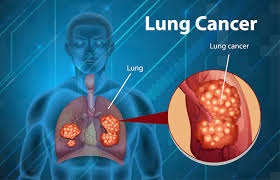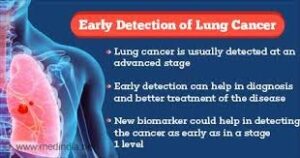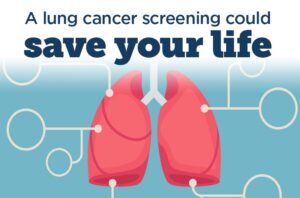LUNG CANCER: EARLY DETECTION MATTERS

Lung cancer remains one of the most challenging cancers to diagnose and treat. Early detection significantly increases the chances of successful treatment and improved outcomes. Understanding the processes involved in diagnosing and screening for it can help individuals and healthcare providers make informed decisions. This comprehensive guide covers the essential aspects of lung cancer diagnosis and screening, including the various methods, their effectiveness, and recommendations for those at risk.
Understanding Lung Cancer

Before diving into the specifics of diagnosis and screening, it’s important to understand what this cancer is. This cancer starts when abnormal cells in the lungs grow uncontrollably, forming tumors that can interfere with normal lung function. There are two primary types of lung cancer:
1. Non-Small Cell Lung Cancer (NSCLC): This is the most common type, making up about 85% of lung cancer cases. It includes several subtypes, such as adenocarcinoma, squamous cell carcinoma, and large cell carcinoma.
2. Small Cell Lung Cancer (SCLC): Although less common, SCLC is more aggressive and tends to spread quickly. It is usually diagnosed at a more advanced stages.
THE IMPORTANCE OF EARLY DETECTION OF LUNG CANCER

Early detection of this dangerous cancer is crucial because it can lead to more effective treatment options and better survival rates. Unfortunately, It often does not cause noticeable symptoms until it has progressed to an advanced stage. This is why screening is an essential tool in catching the disease early, especially for those at higher risk.
DIAGNOSTIC METHODS FOR LUNG CANCER

Diagnosing lung cancer involves several steps and tests. Each method provides different pieces of information that help healthcare providers determine the presence, type, and stage of the cancer. Here are the main diagnostic methods used:
1. IMAGING TESTS
1.1. Chest X-Ray
A chest X-ray is often the first imaging test used when the above mentioned cancer is suspected. It can reveal abnormal areas in the lungs, such as tumors or fluid buildup. However, a chest X-ray alone cannot definitively diagnose lung cancer, as it may not detect small or early-stage tumors.
1.2. Computed Tomography (CT) Scan
A CT scan provides a more detailed image of the lungs compared to a standard X-ray. It can help identify small tumors and determine their size and location. CT scans are often used to guide further testing and biopsy procedures.
1.3. Positron Emission Tomography (PET) Scan
A PET scan is used to assess whether cancer has spread beyond the lungs. This imaging test uses a small amount of radioactive material to highlight areas of high metabolic activity, which can indicate the presence of cancer cells.
2. BIOPSY PROCEDURES
Biopsy procedures are essential for confirming a diagnosis of lung cancer. They involve taking a sample of lung tissue to examine it for cancer cells. There are several types of biopsies:
2.1. Needle Biopsy
A needle biopsy involves using a thin needle to remove a small sample of tissue from a suspicious area in the lung. This procedure is often guided by imaging tests, such as a CT scan.
2.2. Bronchoscopy
Bronchoscopy is a procedure in which a thin, flexible tube with a camera is inserted through the mouth or nose and into the lungs. This allows the doctor to view the airways and take tissue samples from the lungs.
2.3. Thoracotomy
In some cases, a thoracotomy may be necessary. This is a surgical procedure where the chest is opened to access the lungs and obtain a tissue sample. This method is typically used if other biopsy methods are not feasible or if the cancer is suspected to be invasive.
3. MOLECULAR TESTING
Molecular testing involves analysing cancer cells for specific genetic mutations or biomarkers. This type of testing can help identify targeted therapies that may be more effective for the individual. For example, certain mutations may make the cancer more susceptible to specific medications.
SCREENING FOR LUNG CANCER

Lung cancer screening is aimed at detecting the disease in its early stages before symptoms appear. Screening is generally recommended for individuals at high risk due to factors such as smoking history or exposure to certain carcinogens.
1. Low-Dose Computed Tomography (LDCT)
1.1. What is LDCT?
Low-Dose Computed Tomography (LDCT) is the primary method used for lung cancer screening. It involves taking multiple X-ray images of the lungs using a lower dose of radiation compared to a standard CT scan.
1.2. Who Should Get Screened?
The U.S. Preventive Services Task Force (USPSTF) recommends annual LDCT screening for individuals who meet the following criteria:
- Age 50 to 80 years old
- Have a history of heavy smoking (defined as a 20-pack-year smoking history or more)
- Currently smoke or have quit within the past 15 years
1.3. Benefits and Limitations
The primary benefit of LDCT screening is early detection of lung cancer, which can lead to more effective treatment and better outcomes. However, screening also has limitations, including the potential for false positives (indicating cancer when there isn’t one) and false negatives (missing cancer that is present). Regular follow-up and additional testing may be required to address these concerns.
KEY CONSIDERATIONS FOR DIAGNOSIS AND SCREENING OF LUNG CANCER PATIENTS
When considering this cancer’s diagnosis and screening, several factors should be taken into account:
1. Personal and Family Medical History
A thorough review of personal and family medical history is crucial. Individuals with a family history of lung cancer or other cancers may be at higher risk and should discuss screening options with their healthcare provider.
2. Smoking History
Smoking is the leading risk factor for lung cancer. Those with a significant smoking history should consider screening even if they do not have symptoms. Quitting smoking can also reduce the risk of developing above said cancer and improve overall health.
3. Risk of False Positives and Overdiagnosis
While screening can be beneficial, it is important to be aware of the risks of false positives and overdiagnosis. False positives can lead to unnecessary anxiety and additional tests, while overdiagnosis may result in treatment for cancers that may not have caused harm if left untreated.
4. Follow-Up and Further Testing
If a screening test indicates a potential problem, follow-up tests and procedures will be necessary to confirm the diagnosis. It is essential to work closely with healthcare providers to manage and interpret these results effectively.
CONCLUSION
Lastly the diagnosis and screening of this cancer are critical components of managing this challenging disease. By understanding the various diagnostic methods and screening options, individuals can take proactive steps towards early detection and better outcomes. Whether through imaging tests, biopsies, or screening programs like low-dose CT scans, early and accurate diagnosis can make a significant difference in treatment success and overall survival.
If you are at risk or experiencing symptoms, consult with a healthcare provider to discuss the most appropriate diagnostic and screening options for your situation. Regular screening and timely diagnosis are key to effectively combating above mentioned cancer and improving health outcomes.
By staying informed and proactive about lung carcinoma diagnosis and screening, individuals can enhance their chances of early detection and successful treatment, ultimately leading to better health and well-being.
References:
- American Cancer Society (ACS). (2023). “Lung Cancer Types.” Link
- National Cancer Institute (NCI). (2023). “Types of Lung Cancer.” Link
- Mayo Clinic. (2023). “Lung Cancer Diagnosis.” Link
- National Cancer Institute (NCI). (2023). “Lung Cancer Imaging.” Link
- American Cancer Society (ACS). (2023). “Lung Cancer Biopsy.” Link
- Mayo Clinic. (2023). “Types of Lung Biopsies.” Link
- National Cancer Institute (NCI). (2023). “Molecular Testing for Lung Cancer.” Link
- American Cancer Society (ACS). (2023). “Lung Cancer Genetic Testing.” Link
- U.S. Preventive Services Task Force (USPSTF). (2023). “Lung Cancer Screening Recommendations.” Link
- National Cancer Institute (NCI). (2023). “Low-Dose CT Scan for Lung Cancer Screening.” Link
- American Lung Association. (2023). “Lung Cancer Screening: What You Need to Know.” Link
- National Comprehensive Cancer Network (NCCN). (2023). “Lung Cancer Screening Guidelines.” Link
- American Cancer Society (ACS). (2023). “Lung Cancer Diagnosis and Screening.” Link
- National Cancer Institute (NCI). (2023). “Lung Cancer Diagnosis and Screening.” Link
Written by Fawzi Rufai, Medically Reviewed by Sesan Kareem